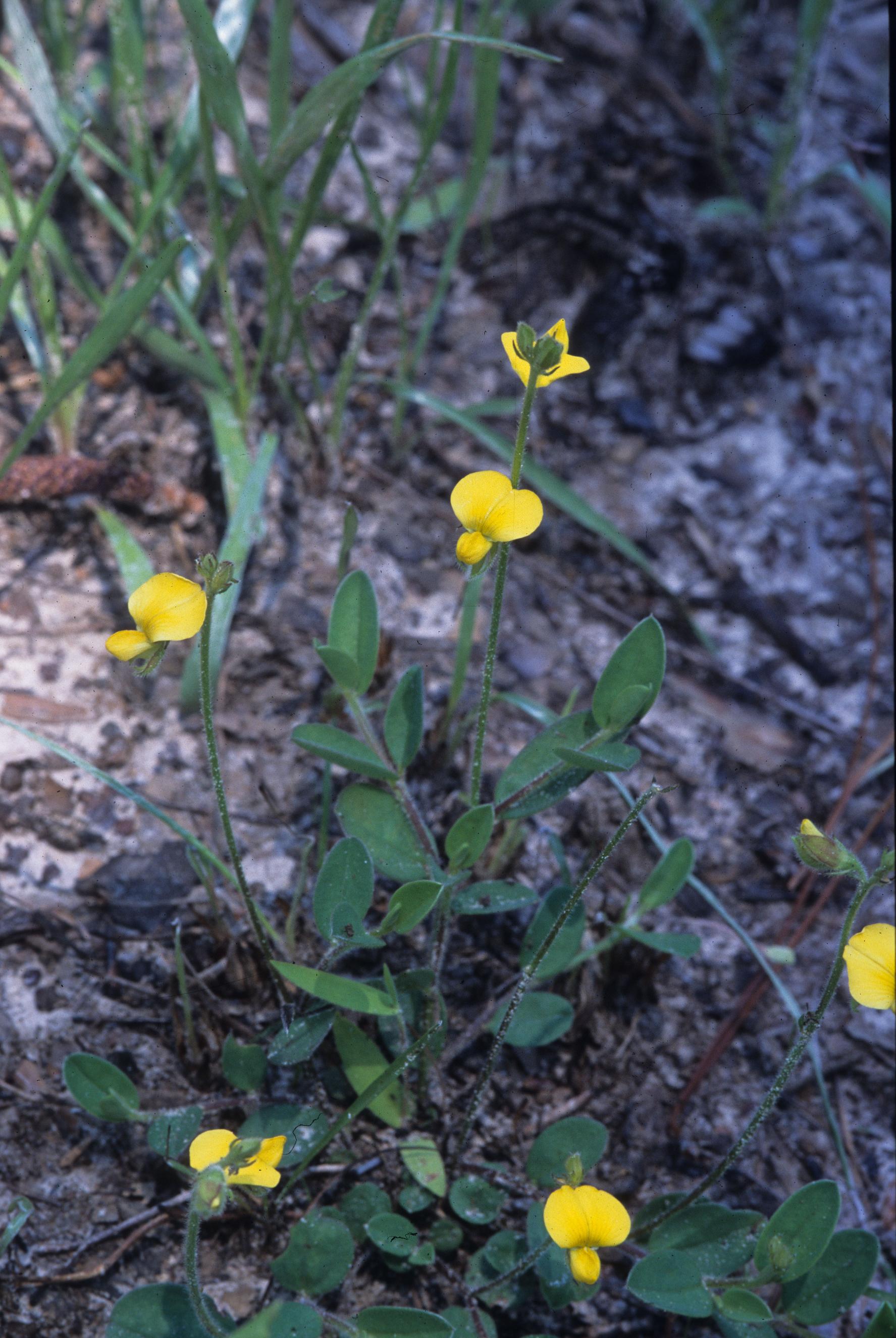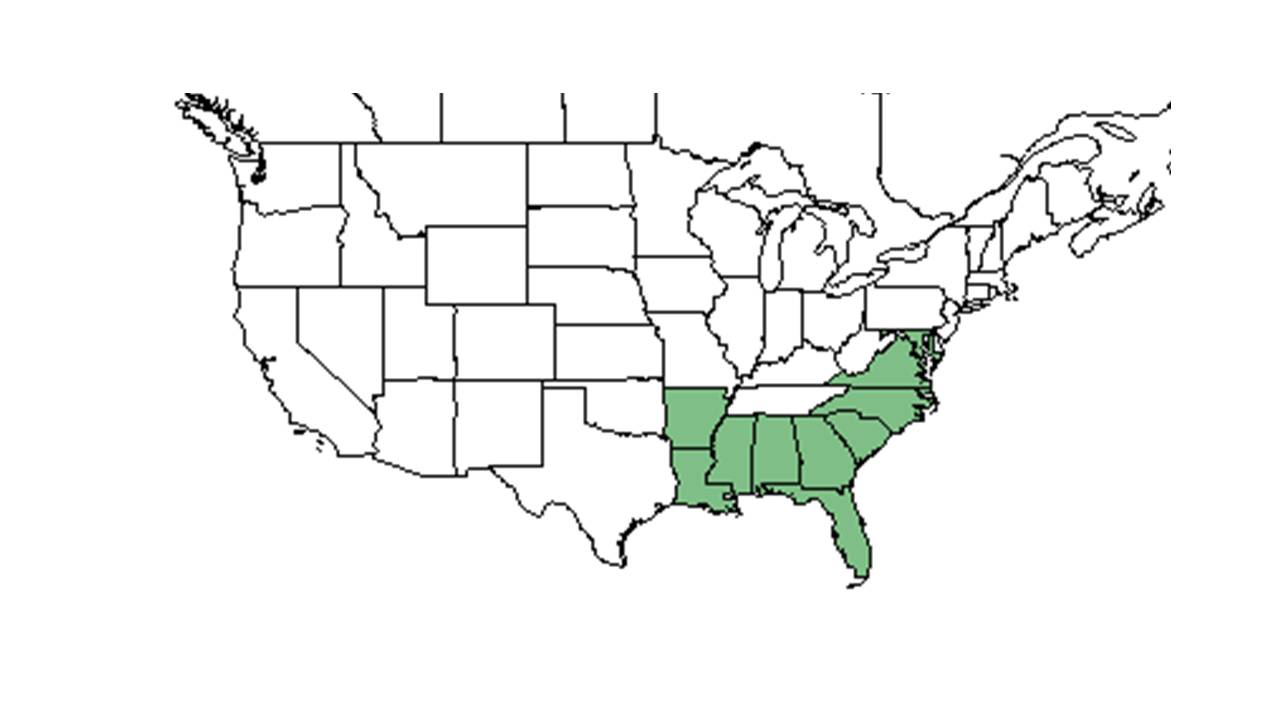Crotalaria rotundifolia
| Crotalaria rotundifolia | |
|---|---|

| |
| Photo was taken by Gil Nelson | |
| Scientific classification | |
| Kingdom: | Plantae |
| Division: | Magnoliophyta - Flowering plants |
| Class: | Magnoliopsida – Dicotyledons |
| Order: | Fabales |
| Family: | Fabaceae ⁄ Leguminosae |
| Genus: | Crotalaria |
| Species: | C. rotundifolia |
| Binomial name | |
| Crotalaria rotundifolia Walter ex J.F. Gmel. | |

| |
| Natural range of Crotalaria rotundifolia from USDA NRCS Plants Database. | |
Common name: rabbitbells
Contents
Taxonomic notes
Synonym: Crotalaria rotundifolia Walter ex J.F. Gmelin var. vulgaris Windler
Description
Perennial herbaceous legume.[1]
Distribution
Southern and eastern United States west to Texas and south to Monroe County, Florida; West Indies, Mexico, and Central America[2].
Ecology
It is a nitrogen-fixing legume.[3] In a study by Davis, it was discovered that C. rotundifolia had higher mortality and less biomass in high carbon dioxide plots, suggesting that not all species will perform well as global carbon dioxide levels rise.[1]
Habitat
This species is a common associate in longleaf pine savannas.[1] It can also be found in sandhill communities,[4] oak-palmetto scrub, evergreen-scrub oak sand ridges, slash pine flatwoods, sand dunes, backdunes, dune swales, and bordering cypress swamps and depression marshes[5]. This species also occurs in disturbed areas including roadsides, clearings in turkey oak barrens, and clear-cut flatwoods..
C. rotundifolia prefers higher light levels associated with open pinelands, and sandy soil types, both moist and dry, such as coarse sand, drying sand, peaty sand, and sandy clay[5].
Associated species includes Rhynchospora, Xyris, Longleaf pine, wiregrass, oak, saw palmetto, Quercus laevis, Q. margaretta, Aristida beyrichiana, slash pine, Polygala nana, Cyperus lecontei, Polypremum procumbens, Crotonopsis, Paronychia, Andropogon, Diospyros, Aristida, Cnidoscolus. Eupoatorium compositifolium, Axonopus affinis and others[5].
Phenology
It has a broad, bimodal flowering phenology with peaks in early April and late fall.[6] Flowering has been observed in March through December, while fruiting has been observed in April through November. [5]
Seed dispersal
Seeds are forcefully expelled after the fruit matures and dries, and ants act as the main dispersal agents. The ballistic dispersal distance was found to be around .94 meters.[4] According to Kay Kirkman, a plant ecologist, this species disperses by explosion mechanisms or by ants. [7]
Fire ecology
Robustness of reproduction is related to burn treatments and season of burn.[6]
Pollination
The following Hymenoptera families and species were observed visiting flowers of Crotalaria rotundifolia at Archbold Biological Station (Deyrup 2015):
Megachilidae: Megachile brevis pseudobrevis
Use by animals
Caterpillars are often found consuming C. rotundifolia. Ants, especially Pogonomyrmex badius, help disperse the seeds long distances.[4].
It is the larval host plant for the ceranus blue (Hemiargus ceraunus) butterfly[2].
Photo Gallery
References and notes
Deyrup, M.A. and N.D. 2015. Database of observations of Hymenoptera visitations to flowers of plants on Archbold Biological Station, Florida, USA.
- ↑ 1.0 1.1 1.2 Davis, M. A., S. G. Pritchard, et al. (2002). "Elevated atmospheric CO2 affects structure of a model regenerating longleaf pine community." Journal of Ecology 90: 130-140.
- ↑ 2.0 2.1 [[1]] Regional Conservation. Accessed: April 15, 2016
- ↑ Runion, G. B., M. A. Davis, et al. (2006). "Effects of elevated atmospheric carbon dioxide on biomass and carbon accumulation in a model regenerating longleaf pine community." Journal of Environmental Quality 35: 1478-1486.
- ↑ 4.0 4.1 4.2 Stamp, N. E. and J. R. Lucas (1990). "Spatial patterns and dispersal distances of explosively dispersing plants in Florida sandhill vegetation." Journal of Ecology 78: 589-600.
- ↑ 5.0 5.1 5.2 5.3 Florida State University Robert K. Godfrey Herbarium database. URL: http://herbarium.bio.fsu.edu. Last accessed: June 2014. Collectors: O. Lakela, Loran C. Anderson, Bian Tan, Brenda Herring, Don Herring, Gwynn W. Ramsey, H. Larry Stripling, R.K. Godfrey, John Morrill, R. Kral, C. Jackson, D. B. Ward, A. F. Clewell, J. Beckner, D. Burch, L B Trott, William Reese, Paul Redfearn, H. E. Grelen, R. C. Phillips, L. J. Brass, Ann F. Johnson, J. Sincock, Grady W. Reinert, Mabel Kral, Elmer C. Prichard, Sidney McDaniel, Roomie Wilson, K. Craddock Burks, W. W. Baker, A. Mellon, Richard S. Mitchell, Steve L. Orzell, Edwin L. Bridges, Patricia Elliot, A. H. Curtiss, Kurt E. Blum, Dave Breil, H. A. Lang, R. F. Doren, R. A. Norris, Walter Kittredge, R. Komarek, Chris Cooksey, Kevin Oakes, M. Davis, Cecil R Slaughter, John B. Nelson, Cynthia Aulbach-Smith, Kelley, Batson, S. M. Tracy, D. P. Bain, R. B. Carr, R. L. Wilbur, J A Duke, H. L. Blomquist, William B. Fox, A. E. Radford, H. R. Reed, Barbara Lund, Grelen, and Wilbur H Duncan. States and Counties: Florida: Bay, Brevard, Calhoun, Citrus, Clay, Collier, Columbia, Dixie, Duval, Flagler, Franklin, Gadsden, Hamilton, Hernando, Highlands, Indian River, Jackson, Jefferson, Lake, Lee, Leon, Levy, Liberty, Madison, Marion, Martin, Monroe, Nassau, Osceola, Orange, Polk, Putnam, Taylor, Santa Rosa, Sarasota, St John’s, Sumter, Suwannee, Volusia, and Wakulla. Georgia: Charlton, Echols, Grady, Lanier, and Thomas. South Carolina: Barnwell, Berkeley, Jasper, and Richland. Mississippi: George, Harrison, Lamar, and Pearl River. Texas: Brazos. North Carolina: Bladen, Carteret, and Wayne. Alabama: Baldwin and Mobile.
- ↑ 6.0 6.1 Hiers, J. K., R. Wyatt, et al. (2000). "The effects of fire regime on legume reproduction in longleaf pine savannas: is a season selective?" Oecologia 125: 521-530.
- ↑ Kay Kirkman, unpublished data, 2015.